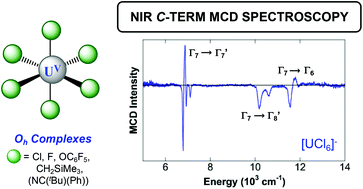Near-infrared C-term MCD spectroscopy of octahedral uranium(v) complexes†
Abstract
C-term magnetic circular dichroism (MCD) spectroscopy is a powerful method for probing d–d and f–f transitions in paramagnetic metal complexes. However, this technique remains underdeveloped both experimentally and theoretically for studies of U(V) complexes of Oh symmetry, which have been of longstanding interest for probing electronic structure, bonding, and covalency in 5f systems. In this study, C-term NIR MCD of the Laporte forbidden f–f transitions of [UCl6]− and [UF6]− are reported, demonstrating the significant fine structure resolution possible with this technique including for the low energy Γ7 → Γ8 transitions in [UF6]−. The experimental NIR MCD studies were further extended to [U(OC6F5)6]−, [U(CH2SiMe3)6]−, and [U(NC(tBu)(Ph))6]− to evaluate the effects of ligand-type on the f–f MCD fine structure features. Theoretical calculations were conducted to determine the Laporte forbidden f–f transitions and their MCD intensity experimentally observed in the NIR spectra of the U(V) hexahalide complexes, via the inclusion of vibronic coupling, to better understand the underlying spectral fine structure features for these complexes. These spectra and simulations provide an important platform for the application of MCD spectroscopy to this widely studied class of U(V) complexes and identify areas for continued theoretical development.



 Please wait while we load your content...
Please wait while we load your content...